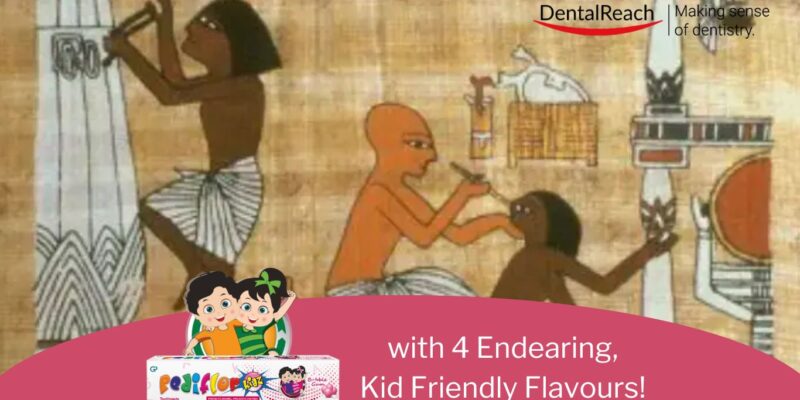(Article 1 of a 5 part series on Dental History)
Abstract
Dentistry, as a specialized field of healthcare, has roots that trace back to ancient civilizations. Long before modern dentistry emerged with its advanced technologies and methodologies, early humans were already addressing dental issues using rudimentary tools and techniques. This article, the first in a 5-part series on dental history, explores the fascinating journey of dentistry from its ancient origins to the structured practice we recognize today.
(BC: Before Christ, a calendar era based on the traditionally reckoned year of the birth of Jesus of Nazareth)
The Dawn of Dental Awareness
The earliest evidence of dental care dates back to 7000 BC in the Indus Valley Civilization (northwest India and modern-day Pakistan). Archaeological findings reveal that these early practitioners used bow drills, typically employed for woodworking and fire-starting, to treat tooth decay. These discoveries suggest an impressive understanding of dental ailments and their treatments.
In ancient Egypt around 3000 BC, there is documentation that highlights how Egyptians dealt with dental problems. Papyrus scrolls reveal detailed accounts of various dental diseases and their treatments. Egyptian physicians often resorted to using honey and myrrh for their antiseptic properties to treat gum disease.
Mesopotamian Contributions
The Sumerians, who inhabited Mesopotamia around 5000 BC, attributed dental pain to “tooth worms.” This belief persisted for centuries across various cultures. Treatments during this period included chewing on medicinal plants or applying crushed herbs directly onto the affected teeth.
Moreover, Babylonian texts from about 2000 BC provide insights into early forms of oral hygiene practices. They used sticks frayed at one end as primitive toothbrushes—a method still observed in some cultures today.
Advances in Ancient Greece and Rome
Ancient Greek civilization made significant strides in understanding oral health. Hippocrates (460-370 BC), often referred to as the “Father of Medicine,” wrote extensively about dentistry. His works include descriptions of tooth extraction methods and treatments for periodontal disease.
In Rome, Celsus (25 BC – 50 AD) documented various surgical techniques for treating oral diseases in his comprehensive medical encyclopedia “De Medicina.” He discussed methods such as tooth extraction with forceps and even procedures resembling modern-day fillings using lead or tin.
Eastern Innovations
In China around 2000 BC, traditional Chinese medicine incorporated aspects of dental care within its holistic approach. Ancient Chinese texts describe the use of acupuncture to alleviate toothache pain—an indication of their advanced understanding of body systems interconnectedness.
Indian Ayurvedic medicine contributed significantly to early dentistry practices. Texts like the Sushruta Samhita (circa 600 BC) detail procedures including tooth extraction and treatment for mouth ulcers using herbal remedies.
Medieval Dentistry: A Transitional Era
During medieval times in Europe, dentistry was not yet recognized as a distinct profession; instead, it was practiced by barber-surgeons who performed a variety of medical procedures including bloodletting and tooth extractions. The famous “barber pole” symbolized their dual role—with red representing bloodletting and white denoting bandages.
Despite limited scientific advancements during this period due to socio-political challenges like wars and plagues, certain manuscripts from Islamic scholars such as Al-Zahrawi (936-1013 AD) provided detailed illustrations on instruments used for dental surgeries which influenced later European practices.
(Medieval Dentistry: Dentistry in the Middle Ages will be covered in Article 2)
Dentistry BC: Timeline by ADA
5000 BC
A Sumerian text of this date describes “tooth worms” as the cause of dental decay.
2600 BC
Death of Hesy-Re, an Egyptian scribe, often called the first “dentist.” An inscription on his tomb includes the title “the greatest of those who deal with teeth, and of physicians.” This is the earliest known reference to a person identified as a dental practitioner.
1700-1550 BC
An Egyptian text, the Ebers Papyrus, refers to diseases of the teeth and various toothache remedies.
500-300 BC
Hippocrates and Aristotle write about dentistry, including the eruption pattern of teeth, treating decayed teeth and gum disease, extracting teeth with forceps, and using wires to stabilize loose teeth and fractured jaws.
100 BC
Celsus, a Roman medical writer, writes extensively in his important compendium of medicine on oral hygiene, stabilization of loose teeth, and treatments for toothache, teething pain, and jaw fractures.
Source: https://www.ada.org/resources/ada-library/dental-history
Conclusion
The history of dentistry is a testament to human ingenuity and resilience in addressing oral health challenges through millennia. From ancient bow drills in the Indus Valley Civilization to sophisticated surgical techniques documented by Greek physicians—each era contributed uniquely towards shaping modern dentistry‘s foundation.
Understanding these ancient origins not only enriches our appreciation for contemporary dental science but also underscores how far we’ve come while inspiring future innovations aimed at enhancing oral healthcare globally.




















Comments